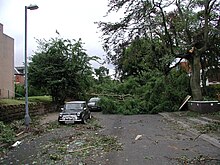| Revision as of 08:13, 10 November 2006 editEvolauxia (talk | contribs)Extended confirmed users, IP block exemptions10,004 edits →See also← Previous edit | Revision as of 19:37, 7 December 2006 edit undoLocalzuk (talk | contribs)Extended confirmed users7,866 editsm reported -> recordedNext edit → | ||
| Line 9: | Line 9: | ||
| There were no fatalities, although there were between 12 and 20 injuries, three of which were reported to be serious. The tornado uprooted an estimated 1000 trees, removed the roofs of buildings, picked up and deposited cars and caused other damage during its short existence. The total cost of damage has been put at £40 million, making it the most costly tornado in British history. | There were no fatalities, although there were between 12 and 20 injuries, three of which were reported to be serious. The tornado uprooted an estimated 1000 trees, removed the roofs of buildings, picked up and deposited cars and caused other damage during its short existence. The total cost of damage has been put at £40 million, making it the most costly tornado in British history. | ||
| While the United Kingdom has more reported tornados, relative to its land area, than any other country excluding the ], the vast majority are weak. The strongest |
While the United Kingdom has more reported tornados, relative to its land area, than any other country excluding the ], the vast majority are weak. The strongest recorded tornado in the country struck ] on ], ] with a T8 rating and a top wind speed of 213 to 240 mph. | ||
| ===Second Tornado=== | ===Second Tornado=== | ||
Revision as of 19:37, 7 December 2006
- This article refers to a tornado in Birmingham, UK. For the 1998 tornado in Birmingham, Alabama, see Birmingham Tornado of April 1998.

The Birmingham Tornado was the strongest tornado recorded in the United Kingdom in nearly 30 years, occurring on 28 July 2005 in the suburbs of Birmingham. It formed on a day when strong tornadoes were expected to develop across the Midlands and eastern England. The tornado struck at approximately 2.30pm BST in the Sparkbrook area of the city, also affecting King's Heath, Moseley and Balsall Heath as it carved a kilometre-long path through the city. Its main effects were felt in the Ladypool Road which bore the brunt of the damage. Ladypool Primary School was extensively damaged and lost its distinctive Martin & Chamberlain tower.
The Met Office and TORRO (The Tornado and Storm Research Organisation) has estimated that the tornado had a general T4 rating on the TORRO scale with a short spell as a T5 tornado, which would mean wind speeds between 93 and 130 mph, equivalent to an F2 on the Fujita scale.
There were no fatalities, although there were between 12 and 20 injuries, three of which were reported to be serious. The tornado uprooted an estimated 1000 trees, removed the roofs of buildings, picked up and deposited cars and caused other damage during its short existence. The total cost of damage has been put at £40 million, making it the most costly tornado in British history.
While the United Kingdom has more reported tornados, relative to its land area, than any other country excluding the Netherlands, the vast majority are weak. The strongest recorded tornado in the country struck Portsmouth on December 14, 1810 with a T8 rating and a top wind speed of 213 to 240 mph.
Second Tornado
Three months later, strong winds and driving rain brought a second tornado, which hit less that a mile away from the original twister. The Met Office said there were winds of up to 80mph and it was strong enough to rip the roof off a corner house. Following this came widespread flooding across the region which brought havoc to Birmingham.
See also
External links
- BBC Birmingham Site
- BBC Birmingham - Pictures by the public
- Birmingham City Council tornado page
- The Balti Triangle Back in Business (photos)
- Forward - Birmingham City Council newspaper
- Pogus Caesar /OOM Gallery Archive - Birmingham Tornado 2005 (291 photos) + video footage